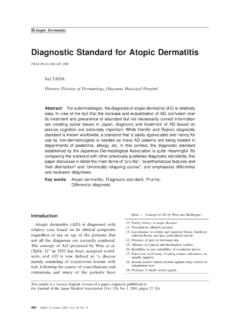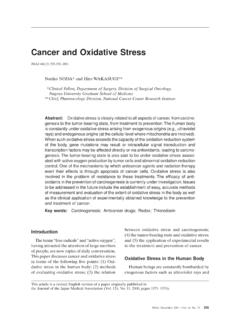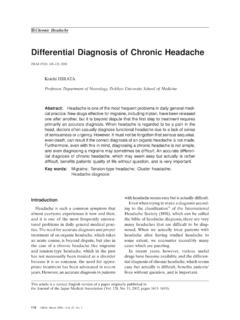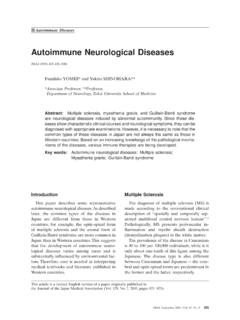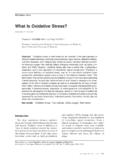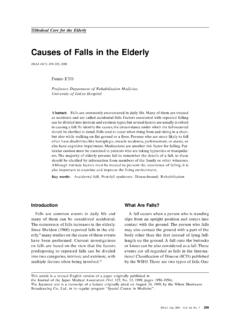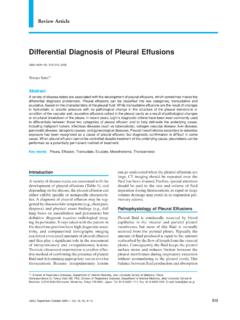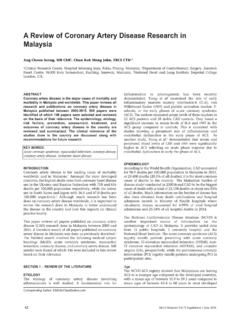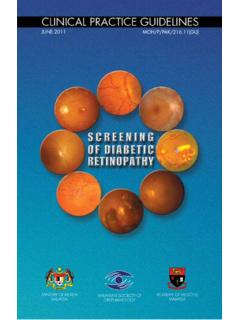Transcription of Healthcare in Singapore: Challenges and management
1 343 JMAJ, September / October 2008 Vol. 51, No. 5 International Medical Community*1 President of the 49th singapore Medical Association Council, singapore Medical Association, singapore Public Health Trainee, Changi General Hospital, the singapore Health Services Group, in singapore : Challenges andmanagementJMAJ 51(5): 343 346, 2008 Chiang Yin WONG,*1 Hsien Chieh LEE*2 Challenges Facing singapore HealthcareThe major Challenges facing Healthcare inSingapore are:a) Healthcare Financingb) An Ageing Population and management ofChronic Diseasesc) Healthcare Manpower Issuesd) Hospital Infrastructuree) Communicable Disease ControlHealthcare financingThe overall Healthcare financing philosophy ofSingapore includes the following:a) Everyone assumes key responsibility for hisown healthb) Healthcare is an example of market failurec) Savings play a predominant role while insur-ance plays a secondary roled) The government will only provide subsidiesfor basic medical caree)There should be no inter-generational transferof liabilities.
2 In other words, every generationpays for itself and each generation cannotexpect the next generation to shoulder theburden of paying for healthcareSingapore s Healthcare financing frameworkis formed by the 3M system Medisave,Medishield and is a state-run compulsory medicalsavings scheme introduced in 1984, under whichevery working employee contributes of his monthly income to a personalMedisave account. The savings can be withdrawneither to pay his own hospital bills, or those ofSingapore Healthcare SystemSingapore, a city-state with a land area of kilometres,1 is located 137 kilometresnorth of the equator at the southern tip ofthe Malay Peninsula. The Republic has a totalpopulation size of million,1 and a populationdensity of 6,489 persons per square at 31 December 2007, there were a total of7,348 registered medical practitioners, out ofwhich 2,781 ( ) were trained specialists in 35recognised The doctor-to-populationratio is 1 : 620,2 and there are about hospitalbeds per 1,000 total Healthcare is easily accessible throughan extensive network of 2,000 private medicalpractitioners clinics, which provide 80% ofprimary Healthcare services, as well as 18 govern-ment polyclinics, which provide the remaining20%.
3 3 In contrast, the public sector accountsfor 80% of tertiary hospital care via 7 publichospitals and 6 national specialty centres, with 16private hospitals accounting for the remaining20%.3 Patients are free to choose their healthcareproviders within this dual Healthcare deliverymodel. The average length of stay in acute carehospitals is days,3 and the average waitingtime for elective surgery is 1 2007, our Life Expectancy at Birth years ( years for males; years forfemales).1 Total Fertility Rate was per female,while Infant Mortality Rate was per 1, The Crude Birth Rate was per1,000 population, and Crude Death Rate was 1,000 , September / October 2008 Vol. 51, No. 5 Wong CY, Lee HChis immediate family is a medical insurance scheme intro-duced in 1990 to help members cover medicalexpenses and protect against financial ruin frommajor illnesses.
4 Premiums for Medishield can bepaid for by savings under the Medisave covers approximately 80% of theSingaporean population is an endowment fund set up in 1993for needy patients who have exhausted all othermeans and cannot afford their medical with an initial capital of S$200 million*3in 1993,3 additional capital injections are madeduring budget surpluses. Only the interest incomefrom the capital sum, which currently stands atS$ billion,3 is utilised. Medifund ensures thatno Singaporean is denied access to the healthcaresystem due to an inability to 2005, singapore spent a total of S$ , the equivalent of Gross DomesticProduct (GDP), on The amountof government Healthcare expenditure made upS$ billion ( of GDP).3 Means testingHealthcare is ultimately a balance betweenaffordability, accessibility and quality.
5 Universalaccess to Healthcare needs two conditions: com-punction and subsidisation. That is, subsidiesare allocated to those who truly cannot affordhealthcare; and those who can be compelled topay what they can afford and thus not use publicfunds unnecessarily. At least 65% of hospitalbeds in singapore public hospitals are heavilysubsidised. As a measure to ensure that thereis universal access to quality Healthcare forSingaporeans without excessive compromise onquality, means testing will be introduced witheffect from 2009 for ageing population and management ofchronic diseasesSingapore has one of the lowest fertility rates inthe world (TFR for 2007: ) and one of thefastest ageing populations. In 2007, of thepopulation was aged 65 years and older.
6 By 2030,this figure will rise to This situation issimilar to other East Asian countries such asJapan and South Korea. With longer life expect-ancies and an ageing population, chronic diseasesbecome more common and thus receive morefocus. The prevalence rates for hypertension,diabetes mellitus and dyslipidemia are , and In 2007, the threemost common causes of deaths were cancer,cardiovascular events and Challenges posed by the demographic andepidemiological shifts have been studied in manycountries and are well known. As such, the shiftfrom episodic care to long-term care, community-based disease prevention, and treatment of chronicdiseases are of these initiatives include:Family medicine and chronic diseasemanagementGeneral practice and long-term care are gainingor regaining prominence.
7 The government isactively engaging family physicians and long-term care givers to play a more important example, Medisave use has been liberalisedsuch that Medisave withdrawals can now bemade for outpatient treatment of 4 chronicdiseases (hypertension, stroke, diabetes mellitusand dyslipidaemia) under the Chronic DiseaseManagement Programme (CMDP) Care Partnership Scheme (Chronic)Recently, the government has announced that itwill also subsidise treatment of chronic diseases ofneedy means-tested patients, under the PrimaryCare Partnership Scheme (PCPS) is an insurance scheme that wasinstituted by the government for the coverage ofpatients with long-term significant manpower issuesSingapore currently suffers from a manpowershortage for specialist medical manpower(specialist-to-population ratio 1 : 1740) and nurses(nurse-to-population ratio 1 : 2307).
8 To addressnursing shortages, the country actively recruitsnurses and nursing trainees from several over-seas countries, including Philippines and country also suffers from insufficientspecialist manpower. It currently has 2,781specialists, with 58% working in the public make it easier to attract foreign specialists orspecialty trainees, the singapore Medical Council(SMC), the statutory body that registers doctors*3 singapore dollar/US dollar exchange rate: 1 US dollar S , September / October 2008 Vol. 51, No. 5 Healthcare IN singapore : Challenges AND MANAGEMENTin singapore , has steadily increased the numberof medical schools it recognises. At the end of2007, 159 medical schools were recognised by theSMC an increase of 39 from the previous infrastructureSingapore s acute hospital beds-to-population ratiois per 1,000 total As the populationages, there is more demand for hospital address this issue, the government is activelybuilding more public hospitals and has releasedmore land for private hospital development.
9 Twopublic hospitals are slated to be completed in thenext few years yielding 1,000 beds while the privatehospital sector will increase by another 500 disease controlSARSThe SARS outbreak in 2003 in Singaporeimparted many painfully important control measures have heightened sincethen. Epidemiologic capabilities have also beenstrengthened in fever, a mosquito-borne diseasefirst recognised in Eastern Africa in the 1950sis endemic in many parts of the tropics andSoutheast Asia. In 2007, 10 cases of Chikungunyafever had been reported in singapore , all ofwhich were imported. This year, a total of 200cases were reported as at 11 September 2008. Ofthese, 97 were imported cases while the remaining103 were locally acquired infections. By virtueof our geographical location, singapore remainsvulnerable to the introduction of Chikungunyaoutbreaks.
10 Precautionary measures against mos-quitoes and measures to eliminate their breedingsites have been put in pandemicSingapore anticipates that a flu pandemic willsoon occur. The singapore Medical Association(SMA) is actively involved in the efforts of theMinistry of Health to prepare for the next flupandemic. Contingency plans have been drawnup to address the pandemic should it include running courses for communitydoctors as well as mock drills and fever is endemic in singapore . In 2007, 188local cases of dengue fever per 100,000 population8were reported. Similar to Chikungunya fever, thefocus of control is aimed at the vector. The com-munity is educated on simple principles of vectorcontrol. The National Environment Agency alsotackles dengue outbreaks by epidemiologic inves-tigations, vector breeding searches and Medical AssociationThe SMA is the national body for the medicalprofession.
